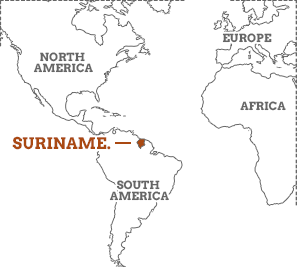Suriname travel guide
One of the three Guianas, Suriname was once known as Dutch Guiana, and is sandwiched between (formerly British) Guyana to the west, and French Guiana to the east. Though they are all distinct in feel, all three countries share the same geography of near impenetrable Amazon rainforest. Suriname’s interior is home to Maroon villages (descendants of Africans who escaped from slavery) and Indigenous settlements, and traveling here means a mix of road and canoe transport.


Descendants of enslaved African workers, European colonists, and Indian, Indonesian and Chinese indentured labourers all contribute to Suriname’s vibrant culture today.![]()

Suriname’s main habitations hug the coast. Here, you’ll find the dynamic capital, Paramaribo, where the country’s melting pot population finds glorious expression, in its handsome Dutch architecture, its temples, mosques and churches standing happily side by side, and in the spicy Indian and South East Asian food that makes Suriname the best place to eat in the Guianas. Traveling here feels adventurous and although many would struggle to find Suriname on the map, those that make it here find heaps to enjoy.
Suriname is/isn't
Suriname is…
Deliciously diverse – and proud of it, with a vibrant capital city where cultures, cuisines and faiths mingle happily.
Suriname isn’t…
Big. It’s South America’s smallest country, covered mostly in rainforest.
Suriname map & highlights
Infrastructure is scarce in Suriname and, with around 90 percent of the country covered in rainforest, there aren’t a lot of roads. Most organised tours take in the three Guianas, relying mainly on a route that follows the coast, linking the three capital cities. It takes about five hours to drive from the border with Guyana, at the Corentyne River, to Suriname’s capital Paramaribo. Heading inland, you can reach Atjoni by road in around three hours – it’s 190km from Paramaribo through hilly landscapes – and from here take a canoe deep into the rainforest. From Paramaribo to Albina on the border with French Guiana is about 150km.
Albina
1. Albina
Albina lies on the west bank of the Marowijne River (Maroni River), which forms the border between Suriname and French Guiana. If you’re traveling between the two countries, you’ll catch a ferry or canoe here, with frequent services between Albina and Saint Laurent. This is also the place to come to catch a boat to Galibi on the coast, to see the nesting turtles.
Atjoni
2. Atjoni
Atjoni is a Maroon village and serves as a landing site where canoes from deeper inland receive goods unloaded off trucks from the capital. It’s also the hopping off point for various eco lodges that lie deeper in the rainforest. Rows of colourful boats, moored on the Upper Suriname River, wait to take you further into the jungle, crossing a handful of rapids as you go.
Galibi
3. Galibi
Sitting on Suriname's eastern shoulder, facing French Guiana across the Marowijne River (Maroni River), Galibi is home to the first and largest indigenous settlement in the Caribbean. You can buy crafts here and see the village church. From February to August look out for leatherbacks and other sea turtle species heading onto Alusjaka beach to lay their eggs.
New Amsterdam
4. New Amsterdam
You can reach the coastal town of Nieuw Amsterdam, near Paramaribo, via land or river. Suriname’s only open air museum is here, on the site of a Dutch fortress built to protect the plantations and later used as a prison. The fortress is almost entirely gone, but other 18th century artifacts and buildings remain, and it’s a nice place to picnic and admire the confluence of the Suriname and Commewijne Rivers.
Paramaribo
5. Paramaribo
Known to locals as ‘Parabo’, Paramaribo is one of South America’s most diverse and surprising capitals. Colonial Dutch buildings line grassy squares (Waterkant is a UNESCO listed street); mosques, cathedrals and Hindu temples sit side by side; there’s sensory overload at the central market and Maroon artists sell paintings on the street. This is a multilingual, ethnically diverse city, with amazing food to match.
Rivers
6. Rivers
The Suriname and Commewijne Rivers converge at New Amsterdam, not far from Paramaribo, and many tours include a boat excursion as a tranquil contrast to the capital. The river banks are lined with old plantation properties divided by canals and on the way, look out for seabirds and pink river dolphins, which often come up to the surface to play alongside the boat.
Our top trip
Guianas tour, small group
A unique tour of Guyana, Suriname and French Guyana
From
£7895
15 days
ex flights
Small group travel:
2024: 29 Feb, 14 Mar, 11 Apr, 22 Aug, 19 Sep, 14 Nov
2024: 29 Feb, 14 Mar, 11 Apr, 22 Aug, 19 Sep, 14 Nov
Contact Us

Call us for a chat about our vacations. We are happy to discuss your vacation and help in any way we can. No bots, queues or awful hold music.
1-866-821-6866
Call toll free
Calling from outside the USA











